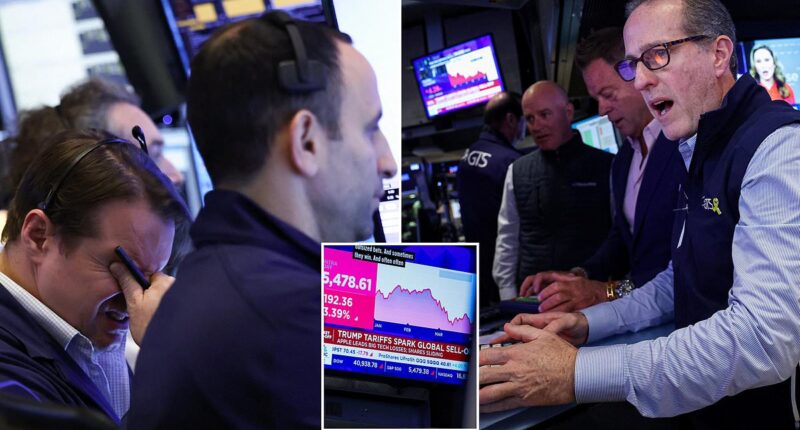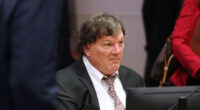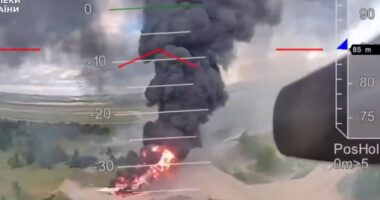A significant drop in the stock market occurred on Thursday, pushing a key index into bear territory due to President Donald Trump’s imposition of tariffs, which raised concerns about a potential US and global economic downturn.
Following the announcement of higher-than-anticipated tariffs by Trump on Wednesday, Wall Street experienced a sea of red as the majority of stocks were losing value, with only a few managing to increase in price.
The situation deteriorated throughout the day, with stock prices continuing to tumble. By 1 pm in New York, the S&P 500 had declined by 3.75 percent, the Nasdaq by 4.8 percent, and the Dow Jones by 2.93 percent. Despite the sharp decline, these indices were showing signs of recovery compared to earlier lows observed at 11 am.
But the small-cap Russell 2000 index — a key benchmark for smaller, US-focused businesses — plunged 5 percent to hit a 52-week low. It is the next largest index after the main three and a bellwether for Main Street
That drop extended its decline from its November 25 record high to 21 percent, officially pushing it into bear market territory.
On Wall Street, a 10 percent drop signals a correction, while 20 percent marks a bear market. Meanwhile, the S&P 500 and Nasdaq remain in correction territory, with the Dow Jones Industrial Average hovering just below that threshold.
Individual stocks took an even bigger battering. Five Below and Wayfair were down 29 percent. Ralph Lauren, Dockers and Dell down 17 percent. Nike was down 12 per cent. Apple down 8 per cent.
Trillions of dollars was wiped off the value of US stocks — a blow that will also hit ordinary Americans whose retirement savings, including 401(K) are tied to the market.

A Specialist trader works at his post on the floor at the New York Stock Exchange (NYSE) in New York City, U.S., April 3, 2025.

Traders work on the floor of the New York Stock Exchange (NYSE) at the opening bell in New York City, on April 3, 2025. Wall Street stocks sank in early trading on April 3,2025, joining a global equity selloff after President Donald Trump’s latest tariff announcement exacerbated worries about a trade war and global economic downturn

The Russell 2000 is now down 21 per cent since its high on November 25. The graph above shows how it has fared over the past six months, over which time it is down 11.45 percent.

The Nasdaq plunged at market open on Thursday morning – down a huge 4.6 per cent by 9.45am
Retail experts say tariffs will also push up prices for shoppers since they are so big companies will have to pass on higher costs.
Companies that rely on imports were down the most, since they will now be hit by tarifs as high as 54 percent for cheap goods from Asia.
Wall Street had hoped the sharp sell-off would encourage the Federal Reserve to cut interest rates. But Fed member Philip Jefferson, speaking Thursday afternoon, said there were no plans to change track on the twoo planned cuts for 2025.
‘The silver lining for investors could be that this is only a starting point for negotiations with other countries and ultimately tariff rates will come down across the board,’ Northlight Asset Management’s Chris Zaccarelli wrote in a note to clients. ‘But for now traders are shooting first and asking questions later,’ he added.
On Thursday morning, Commerce Secretary Howard Lutnick dismissed the possibility of exemptions for certain countries under the new US tariffs.
‘I don’t think the word exemption is going to be a factor. I don’t think that’s such a thing,’ Lutnick said on CNBC’s Squawk Box.
Lutnick also warned that other nations would be making a mistake if they retaliated with their own tariffs against the U.S.
Trump made his tariff announcement Wednesday afternoon in the White House Rose Garden, unveiling broad 10 percent tariffs — with even higher rates for certain countries. This includes 34 percent on China, on top of an existing 20 percent tariff. For the European Union, it is 20 percent, much higher than expected. Tariffs will be25 percent on South Korea, 24 percent on Japan and 32 percent on Taiwan.
By then, Wall Street had closed, but futures tied to major US indexes immediately nosedived as investors worried about rising inflation and economic fallout.
Overnight, global stocks tumbled as recession fears spread. Japan’s Nikkei index sank tumbled more than 3 percent, while South Korea’s Kospi slipped 1.5 percent. In Australia’s main index dipped 1.9 percent, heading for its worst single-day decline since September.
Trump on Wednesday accused foreign nations of ‘ripping off’ the United States. He announced a baseline 10 percent tariff on all imports, effective April 5, with higher rates for countries imposing steeper duties on US goods.
Trump confirmed that a 25 percent tariff would be imposed on all foreign cars imported to the US starts Thursday.

trader runs on the floor of the New York Stock Exchange (NYSE) at the opening bell in New York City on April 3, 2025. Wall Street stocks sank in early trading on April 3,2025, joining a global equity selloff after President Donald Trump’s latest tariff announcement exacerbated worries about a trade war and global economic downturn.

A trader works on the floor at the New York Stock Exchange (NYSE) in New York City, U.S., April 3, 2025.

President Donald Trump holds up his signed executive order at the conclusion of his event in the Rose Garden introducing substantial reciprocal tariffs
The president used aggressive rhetoric to describe a global trade system that the United States helped to build after World War II, saying ‘our country has been looted, pillaged, raped, plundered’ by other nations.
He has promised that factory jobs will return back to the United States as a result of the taxes, but his policies risk a sudden economic slowdown as consumers and businesses could face sharp price hikes on autos, clothes and other goods.
‘Taxpayers have been ripped off for more than 50 years,’ Trump said in remarks at the White House. ‘But it is not going to happen anymore.’
He condemned ‘foreign scavengers.’ And he talked of other nations that had ‘pillaged, raped and plundered’ the U.S. and ‘foreign cheaters’ who ‘ransacked’ American factories.
It took nearly 20 minutes before Trump shared the tariff details.
‘For nations that treat us badly we will calculate the combined rate of all their tariffs, non-monetary barriers and other forms of cheating. And because we are being very kind … We will charge them approximately half of what they charge us,’ Trump said.
Trump then held up a large sign that showed the calculations. As Trump went through the chart, he knocked even some of the U.S.’s closest allies for charging import taxes.
‘The European Union. They’re very tough, very, very tough traders. You think of European Union, very friendly. They rip us off. It’s so said to see. It’s pathetic,’ Trump said. ‘Thirty-nine percent, we’re going to charge them 20 percent, so we’re charging them essentially half.’

President Donald Trump holds up a giant chart showing some of the reciprocal tariffs his administration plans to charge foreign countries. Every country will be charged at least a 10 percent tariff to import goods to the U.S.
The largest tariff will hit the African nation of Lesotho, at a rate of 50 percent.
Canada and Mexico were exempt from Wednesday’s tariff announcement, due to the president already charging them 25 percent excluding the goods outlined in the trade agreement from Trump’s first administration.
‘They all understand, we’re gonna have to go through a little tough love maybe? But they all understand. They’re ripping us off and they understood,’ Trump said.

















